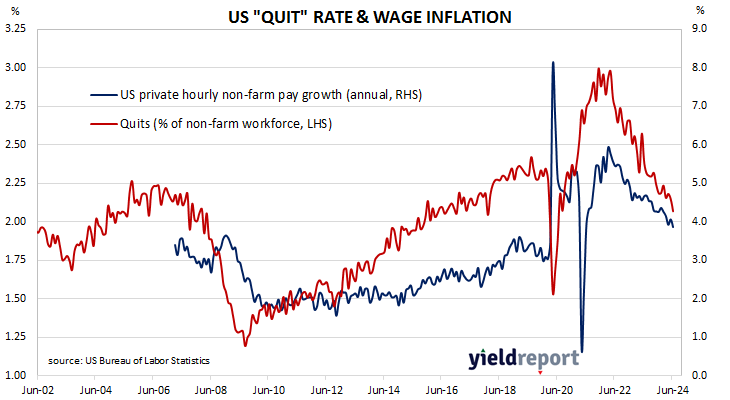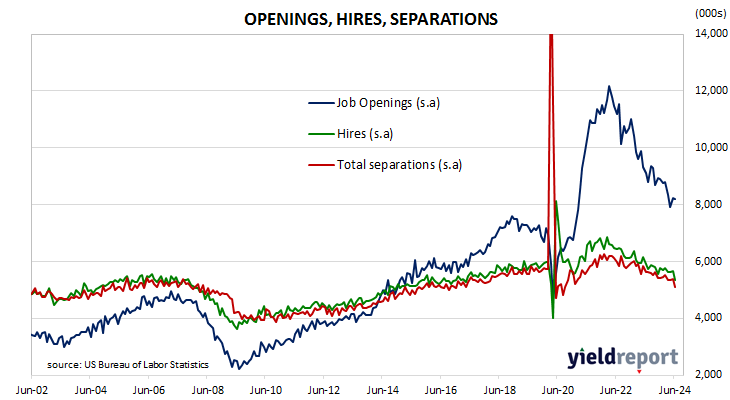Summary: US quit rate steady at 2.1% in June after revisions; Westpac: US labour demand, supply broadly balanced; US Treasury yields fall; expectations of Fed rate cuts firm; job openings relative to employment broadly in line with pre-pandemic averages; fewer quits, openings, separations.
The number of US employees who quit their jobs as a percentage of total employment increased slowly but steadily after the GFC. It peaked in March 2019 and then tracked sideways until virus containment measures were introduced in March 2020. The quit rate then plummeted as alternative employment opportunities rapidly dried up. Following the easing of US pandemic restrictions, it proceeded to recover back to its pre-pandemic rate in the third quarter of 2020 and trended higher through 2021 before easing through 2022, 2023 and the first half of 2024.
Figures released as part of the latest Job Openings and Labor Turnover Survey (JOLTS) report show the quit rate remained steady in June after revisions. 2.1% of the non-farm workforce left their jobs voluntarily, unchanged from May after rounding. Quits in the month decreased by 121,000 while an additional 206,000 people were employed in non-farm sectors.
“Separation and quit rates also point to labour demand and supply being broadly balanced with a normal degree of churn,” said Westpac economist Jameson Coombs.
The report was released on the same morning as The Conference Board’s latest consumer confidence survey and US Treasury yields fell moderately across the curve on the day. By the close of business, 2-year and 10-year Treasury bond yields had both shed 4bps to 4.36% and 4.14% respectively while the 30-year yield finished 3bps lower at 4.40%.
In terms of US Fed policy, expectations of a lower federal funds rate in the next 12 months firmed, with at least five 25bp cuts currently factored in. At the close of business, contracts implied the effective federal funds rate would average 5.315% in August, 2bps less than the current spot rate, 5.205% in September and 4.915% in November. June 2025 contracts implied 4.00%, 133bps less than the current rate
The fall in total quits was led by 64,000 fewer resignations in the “Construction” sector while the “Professional and business services” sector experienced the largest increase, rising by 82,000. Overall, the total number of quits for the month decreased from May’s revised figure of 3.403 million to 3.282 million.
“While the number of job openings is still meaningfully above the pre-pandemic average, relative to employment, job openings are broadly in line with pre-pandemic averages,” Coombs added.
Total vacancies at the end of June decreased by 46,000, or 0.6%, from May’s revised figure of 8.230 million to 8.184 million. The fall was driven by 88,000 fewer open positions in the “Durable goods” sector while the “Accommodation and food services” sector experienced 120,000 more offerings, the single largest increase. Overall, 12 out of 18 sectors experienced fewer job openings than in the previous month.
Total separations decreased by 302,000, or 5.6%, from June’s revised figure of 5.397 million to 5.095 million. The fall was led by the “Construction” sector where there were 80,000 fewer separations while the “Retail trade” sector experienced 6,000 more separations. Separations decreased in 10 of the 18 sectors.
The “quit” rate time series produced by the JOLTS report is a leading indicator of US hourly pay. As wages account for around 55% of a product’s or service’s price in the US, wage inflation and overall inflation rates tend to be closely related. Former Federal Reserve chief and current Treasury Secretary Janet Yellen was known to pay close attention to it.



